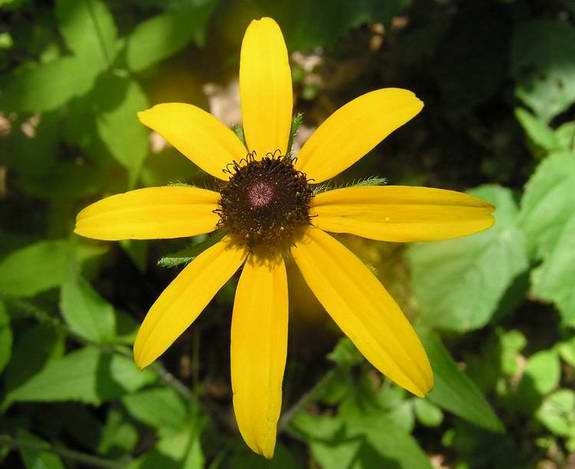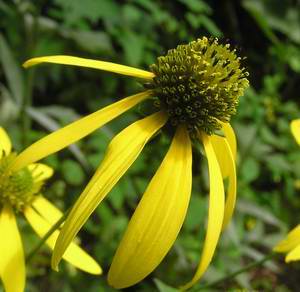|
Return to Hiker's Notebook Home Page
Common Name: Black-eyed Susan, Brown-eyed Susan, Brown Betty, Golden Jerusalem, Yellow daisy, Brown daisy, Poorland daisy, English bull's eye - The dark color of the central floret disk provides the black-eyed metaphor. There is no known attribution for the assignation of the name Susan (or Betty for that matter). It is likely that it is a one of the more common woman's name given to one of the more common flowers.
Scientific Name: Rudbeckia hirta - The generic name is from Olof Rudbeck, a noted professor of medicine at the University of Uppsala in Sweden (see below). The species hirta is the Latin word for hairy or prickly; the stem and leaves are covered with hairs giving the plant a rough texture.
The Swedish physician and botanist Carl Linn�, who is more commonly known by the Latinized Carolus Linnaeus, is credited with the establishment of the genus and species nomenclature for the classification of plants and animals into the now familiar taxonomy. His choice of Rudbeckia was not random, as Olof Rudbeck (also Latinized as Olaus Rudbeckius) was a professor of medicine at Uppsala University to which Linnaeus matriculated in 1728, becoming his student. The highly regarded Rudbeck recognized the abilities of the aspiring physician and became something of a mentor and friend; it is posited that Linnaeus moved into the professor's house and was remunerated by him for tutoring an indeterminate number of Rudbeck's twenty-four progeny. Linnaeus, however, became more interested in botany (a knowledge of medicinal plants was essential for a practicing physician in the 18th Century), and looked to the veteran botanist Olof Celsius (whose nephew Anders invented the eponymous temperature scale) for inspiration. His profound influence with the publication of the seminal Systema Naturae led to a patent of nobility from the Swedish Crown in 1761 and he became thereafter Carl von Linn�.
The coneflowers are members of the Asteraceae or Compositae family, which is
commonly called either the sunflower or daisy family; it is the second largest
family of flowering plants (after orchids) with about 20,000 species.
Composite flowers are generally characterized by tubular disk flowers (called
florets) which occupy the central head and ray flowers around the margin of
the head with
The black-eyed Susan and the green coneflower are native to the prairies west of the Mississippi and were not found in Eastern states until about 1830, their transport thought to have been attendant to an inadvertent mixing with red clover seeds (imported to improve the nitrogen fixation capacity of the depleted eastern soils). Composite flowers spread rapidly due to the profligacy of their seed production and the two Rudbeckias accordingly infested the farm fields of the East with celerity. The Chippewa of the Great Plains called the green coneflower gizuswebigwais meaning "it is scattering." Farmers complained of livestock poisoning though there has never been any definitive proof of this, though it is certainly plausible. Both plants were used by Native Americans for a variety of medicinal purposes including as a root tea for worms and indigestion and poulticed as a vulnerary for external application to burns and sores. Both plants have demonstrable medicinal properties and it is accordingly not illogical that excessive consumption by livestock could result in deleterious consequences.
State flowers became popular after they were advocated at the 1893 Chicago World Columbian Exposition and in 1896 a group of women who attended a meeting at the Maryland Agricultural College selected the black-eyed Susan as Maryland's state flower.. Twenty years later, Maryland adopted the black-eyed Susan as the "Floral Emblem" by an act of the General Assembly in 1918 (Chapter 458, Section 13-305). Following the tradition of the Kentucky Derby to drape a floral blanket over the winning horse (roses were first used to this purpose in 1896, the phrase "run for the roses" was coined in 1925), the Preakness organizers established a similar tradition with Maryland's black-eyed Susan. Ironically, the flower is not in bloom when the race is run, so yellow daisies are used instead, the heads hand-painted black to achieve the ersatz association. |

 strap-like extensions that forms the surrounding petals; some composites have
only ray flowers (
strap-like extensions that forms the surrounding petals; some composites have
only ray flowers (